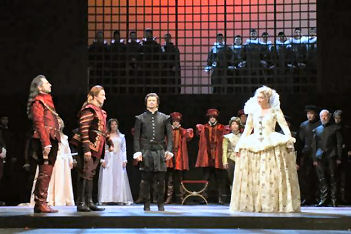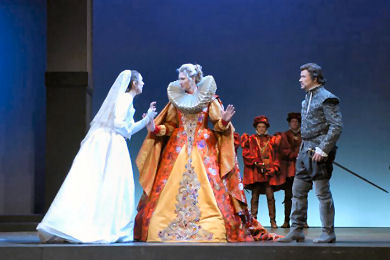|
Editor: Marc Bridle
Webmaster: Len Mullenger
|
Seen and Heard International
Opera Review
Giacomo Meyerbeer, Les Huguenots: soloists, chorus and orchestra of the Opéra Royal de Wallonie, Liège, Belgium, Jacques Lacombe (conductor), Robert Fortune (director), Christophe Vallaux (scenery), Rosalie Varda (costumes), Jean Michel Bauer (lighting), Edouard Rasquin (chorus director), 21 June 2005 (ED)
Marguerite de Valois: Annick Massis Valentine: Barbara Ducret Urbain: Marie-Belle Sandis Raoul de Nangis: Gilles Ragon Le comte de St Bris: Philippe Rouillon Le comte de Nevers: Patrice Berger Marcel: Branislav Jatic Cossé: Guy Gabelle
The Opéra Royal de Wallonie certainly has ambitions above its station. Their home, the Théâtre Royal in Liège, is a perfectly charming medium sized provincial theatre whose worn appearance is strangely endearing. It survives largely due to funding from Regional government and staunch local support. As reward, an ambitious programme is mounted annually: this production of Les Huguenots closes the current season, and proves an appropriate foil to two complete cycles of Richard Wagner’s tetralogy that opens next season. The Wagner music-dramas have been staged separately since 2003, as preparation for the complete cycles.
Not that size is everything when it comes to staging opera. There are works that are frequently staged in theatres too large to be appropriate for them: witness Massenet’s Werther, essentially an intimate domestic drama, staged in the cavernous Covent Garden earlier this season. Indeed, it is works such as the Massenet that the Liège theatre is ideally suited to, and it is so understandable why the Meyerbeer was chosen to open Covent Garden in 1858. Taking arguably the grandest of all French grand operas in Les Huguenots and presenting it in the Liège house could give it an intimacy and added immediacy too, if handled correctly.
True, the action did have a degree of intimacy appropriate to the scale of the stage; though intimacy in no way reflects upon the scale of the production. In this respect it was truly grand opera with seemingly no expense spared. The staging showed large effects often through minimal means – a strikingly coloured backdrop, or a moodily lit battle scene – showing that acute eyes were at work, giving a production of which any house could be proud.
Musically, it was a slightly different matter. The playing, though not front rank or overt weight, was at least musical and characterful where Meyerbeer allowed for it. Jacques Lacombe, a conductor with experience of big houses such as the Met in New York, tried to move things along, though inevitably pressed the big moments of crowd scenes and choruses hard. In this, by comparison, he missed some dramatic big moments that internally affect individual characters, which should have (and could have) made a stronger impression in an intimate house. Amazingly, some unevenness in Meyerbeer’s writing also became apparent, something that had not really struck me before, in his use of different effects and musical groupings to try and give overall cohesion. Bare recitative accompaniments brought to mind stretches of Boito’s Mefistofele, though are countered elsewhere by passages of inventiveness. Perhaps this unevenness, along with the length – around three and three-quarter hours (the ballets were cut in this production!) – and the demands made on singers to deliver a style that has long since fallen from fashion cumulatively account for the work’s all but total disappearance from the staged repertoire.
In the lead roles, and really there are seven, Meyerbeer is taxing with his vocal writing. Solo lines are sometimes written against chorus or chamber scaled accompaniments, requiring a variety of qualities, not least stamina. The ladies coped better on the whole, with Annick Massis most at ease with the idiom. However, sometimes she lacked the requisite power to bring out the full range of emotion in her characterization. Barbara Ducret’s Valentine was vividly acted both internally and in larger scenes, though sometimes she sounded a shade lackluster, which could not be said of Marie-Belle Sandis in the trouser role of Urbain.
Patrice Berger’s Comte de St Bris was robustly sung in a bass of real vitality and thoroughly moving in the final scene when he mistakenly shoots his daughter Valentine. Branislav Jatic’s Marcel was victim to poor acting and a voice that faded in the lower register, making his protests against Raoul’s allegiances and actions appear all the more futile.
Gilles Ragon’s tenor as Raoul proved an all or nothing experience. In certain Meyerbeer circles there had been politely stated surprise that he was to assume the role, and I can understand why. In piano passages he often appeared to mark down somewhat, obviously husbanding resources for his big moments, which are many and extended. When the voice came it was not particularly individual and often tended towards roughness. Appearing faintly comical throughout, indeed his ‘other’ career is as a comedian, acting was largely limited to stock facial expressions and gestures. Only in the final two acts did he, and indeed the production, gain much immediacy and dramatic inevitability that should have driven it from the start.
This production showed achievement largely out-vaulted by ambition, and Meyerbeer’s greatest triumph wanting for stronger advocacy. Wagner would have delighted in this, but there, too, perhaps might be some warnings for the coming Ring.
Evan Dickerson
Pictures © Opéra
Royal de Wallonie 2005 Back to the Top Back to the Index Page |
| ||
|
||||





